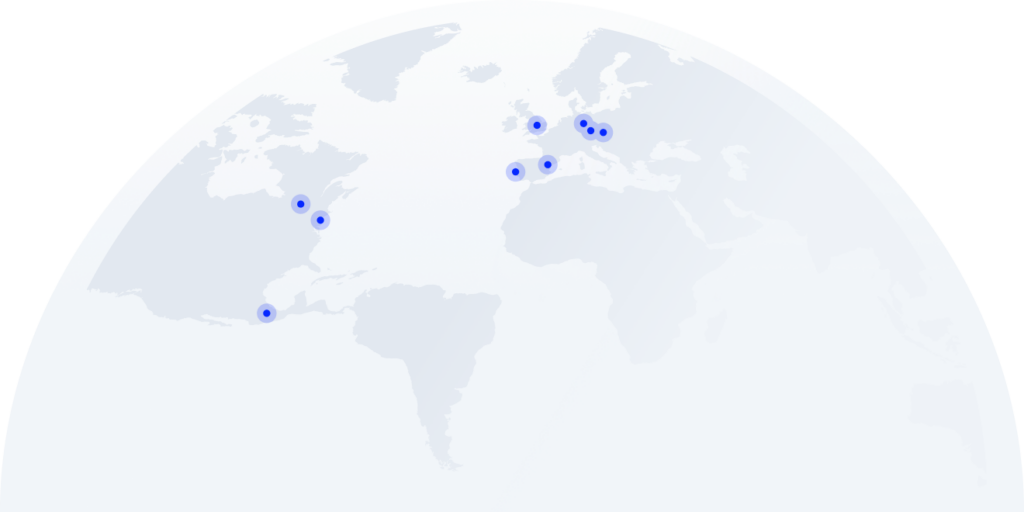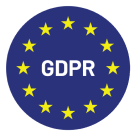Omnichannel Call Center: Benefits and Tools for Managers

Reports show that 79% of customers* expect consistent interactions across departments. And it makes sense… Imagine James, a loyal customer, who recently browsed your website for a new laptop, chatted with a representative about the specs via live chat, and decided to call customer service to confirm some final details.
When he connects with your call center, he’s expecting the agent to know his purchase history, the prior chat conversation, and his concerns about finding the right model. Instead, James is greeted with no context — he has to re-explain everything from scratch. The result? Frustration.
Now imagine the opposite. James calls in, and the agent immediately pulls up his previous interactions across channels. They confirm details, resolve his questions, and confidently close the sale. That seamless experience makes James more likely to trust your business, buy the laptop, and even recommend your brand to friends.
But how can you provide this kind of experience without taking up hours of agent time?
The answer is the power of an omnichannel approach to customer support. In this article, we’ll look at what an omnichannel call center is, why you need one, and the tools required to make it all happen.
Key Takeaways:
- An omnichannel call center improves the customer experience by personalizing interactions across every touchpoint.
- The right tools can centralize customer data and allow agents to access comprehensive customer profiles and interaction history.
- Omnichannel platforms like CloudTalk can synchronize call data with CRM and customer service platforms while providing real-time analytics.
Transform your omnichannel support
What Is an Omnichannel Call Center?
An omnichannel call center integrates customer communication channels, like phone calls, SMS text messaging, emails, and social media, into a single unified space.
Unlike with a multichannel contact center, these channels work together and you can jump between them easily based on customer needs. For example, you might text a customer to confirm an appointment, follow up with a call if they don’t respond, and then send an email after you have a conversation—managing all these touchpoints using one solution.
Omnichannel call centers empower management and agents with a complete top-down view of the customer journey. This way, it’s easier to understand what customers’ preferred channels are. Plus, the agent handling the call has visibility over the whole interaction.
This means agents have more context and can work to improve first-call resolution rates. It also means that customers don’t have to repeat themselves, dramatically improving the customer experience.
The key features of a successful omnichannel call center include:
- Unified customer profiles: Data from all channels is aggregated to give agents a holistic view of all customers.
- Seamless channel handoff: Customers can switch between communication channels without losing context.
- Integrated Analytics: Interactions across each channel are recorded, stored, and analyzed to track customer behavior and agent performance.
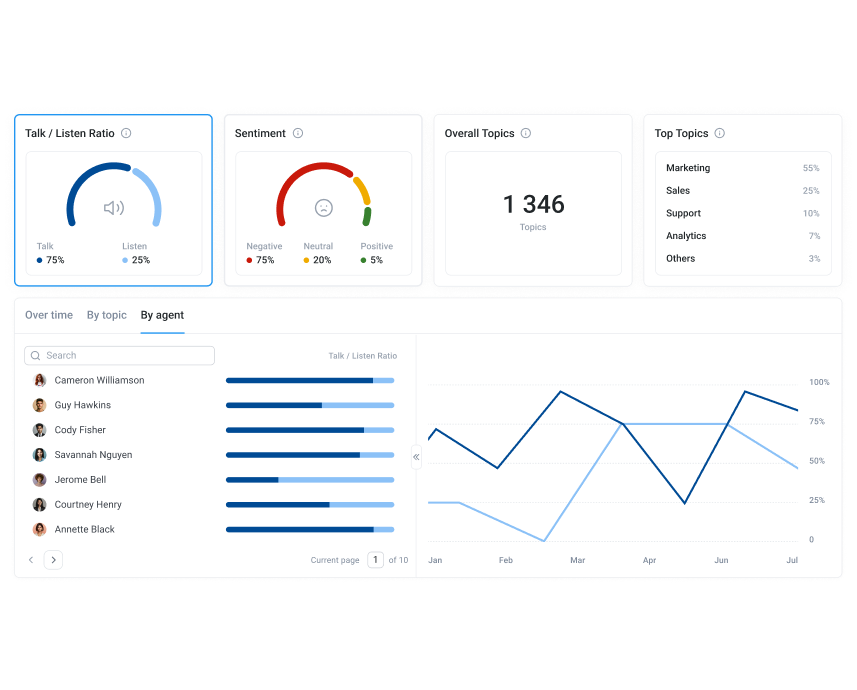
Why is an Omnichannel Call Center Essential?
Communication in traditional multichannel call centers is siloed and fragmented. This presents multiple challenges that harm the customer experience and put a damper on operational efficiency.
The experience can be even more disjointed when switching between different communication channels. It also shows a lack of understanding or respect for people’s time on the business side, which is a massive red flag when trying to build trust and loyalty.
Think again of James. After chatting about laptop specs, he sends a follow-up email. Frustrated by no reply, he calls support, only to start over with an agent unaware of his prior interactions.
Now imagine an omnichannel approach: The agent sees his chat and email, resolves his concerns seamlessly, and even apologizes for the delay. James feels valued, trust is restored, and he confidently makes a purchase.
What’s more, this frustration isn’t limited to your customers. Fragmented data from dispersed channels can also create bottlenecks in service delivery. This reduces productivity while agents comb through multiple information streams to accurately understand a problem.
At a strategic level, this also means that customer data is scattered across different channels. This makes it difficult to compile useful customer profiles and hampers efforts to make service more personalized. It also means that the analysis of customer behavior is messy and inefficient.
Together these issues can lead to customer churn and lost revenue opportunities.
Consolidate your customer data
Key Benefits of Omnichannel Contact Centers
An omnichannel approach allows agents to respond to more customer needs, fast.
Here’s how.
Improved Customer Experience
In an omnichannel customer experience, everybody agents interact with has equal context. This means there’s no drop in quality when changing communication channels and customers get consistent and personalized service across whichever channel they use.
Agents can also follow-up in a more timely and relevant way, so even when the problem isn’t solved, first-time frustration is kept to a minimum. So you can expect faster resolution times as agents are given comprehensive customer data to resolve issues quickly.
Agents can provide proactive support by anticipating customer needs before they come up, further enhancing customer loyalty.
In James’ case, the agent might see his previous chat about laptop specs and his follow-up email. Armed with this context, they not only answer his questions but also suggest accessories based on his needs.
Increased Operational Efficiency
An omnichannel solution doesn’t just make things faster for customers. With tools and processes consolidated the entire call center workflow becomes more efficient.
For example, instead of jumping between different platforms for different issues, agents can handle all daily interactions through a single interface. This saves time while reducing errors and significantly boosting agent productivity.
SaaS sprawl (where companies end up with too many software tools) is also a concern for many call centers. An omnichannel approach can also save costs by reducing the number of individual tools needed to offer great service.
Actionable Insights with Integrated Data
An omnichannel approach provides strategic insights. By integrating customer data across all channels, it’s easy to leverage advanced analytics to monitor performance, identify trends, and make data-driven decisions.
Some omnichannel platforms also take this a step further, leveraging powerful features like artificial intelligence-powered Sentiment Analysis. This uses AI to assess the emotions behind customer interactions during a call, flagging to agents and managers when customers’ moods shift and encouraging them to adjust their approach accordingly.

Better Team Collaboration
Not only do all agents have the same context when starting an interaction, but shared insights across different departments can lead to more cooperation and alignment.
When teams have access to unified data sharing of customer information they can collaborate more effectively and align on how to ensure a seamless customer experience.
Some omnichannel platforms also have advanced tools to allow agents to communicate and advise each other all in the same window, allowing for rapid real-time answers to queries.
Tools to Unify Your Omnichannel Call Center
To set up an effective omnichannel call center, you need a suite of tools that unify your communication channels and streamline operations.
Here’s a rundown of the key platforms, tools, and features to transform your call center along with tips on successfully implementing them.
CRM Integration
Chances are you’re already using software with some level of CRM functionality. But by choosing a solution that integrates with your call center software and wider tech stack, you can revolutionize the customer experience with a more personalized service.
Call data and customer profiles will be completely centralized and agents will have access to every piece of relevant information needed during a conversation in one window. This prevents agents from needing to toggle between software and reduces the need for customers to repeat themselves. It also means agents can adjust their approach based on previous interactions.
Operational efficiency is also greatly improved with CRM integration, as routine tasks like data entry and call logging can be automatically recorded within the CRM. This reduces response times by removing admin from the customer service process.
It’s important to select a CRM that provides the most seamless contact center experience on the market. Major players each have different value propositions:
Salesforce is renowned for its extensive capabilities, offering the ability to manage customer relationships with features like management, lead tracking, and opportunity management, for example. Meanwhile, HubSpot offers a particularly user-friendly UX and a comprehensive suite of tools allowing sales, customer service, and marketing to share a unified platform.
Customer Service Platforms
You could also consider dedicated customer service platforms like Zendesk. These are perfect for omnichannel customer service call centers and integrate various support channels into a unified interface, much like a CRM does for sales.
For example, Zendesk can consolidate customer support channels like email, live chat, and SMS messaging into one view. With a Zendesk integration to call solutions like CloudTalk, you can also add voice calls to the mix, providing a comprehensive omnichannel hub to support customer service.
Call Management Solutions
While an omnichannel approach balances multiple communication channels, voice calls are still a huge part of customer service. McKinsey found respondents of all ages still preferred voice calls when seeking help and support, and 6 in 10 contact centre leaders predict call volumes will rise by 20% over the next two years.
Effectively managing these calls requires agents to have the right tools and managers to understand what’s really happening on the ground.
So, your call solution needs to ensure incoming calls are directed to the right group of agents. This reduces wait times, balances workloads, and boosts first-call resolution rates.
But this is just one piece of the puzzle. Platforms like CloudTalk offer other advanced features to improve the customer experience. For example, automatic Call Recording and summaries record all conversations and store them in the cloud for quality assurance and training.
Managers can then review those recordings to tailor feedback and identify gaps that need to be closed with extra support. For example, training packages can be designed around common customer issues or effective resolution techniques.
Meanwhile, Callbacks allow customers to choose a callback instead of sitting on hold. This reduces queues during peak times and drives a better customer experience. It also allows agents to work more efficiently and spreads work evenly between those in the queue and those waiting.
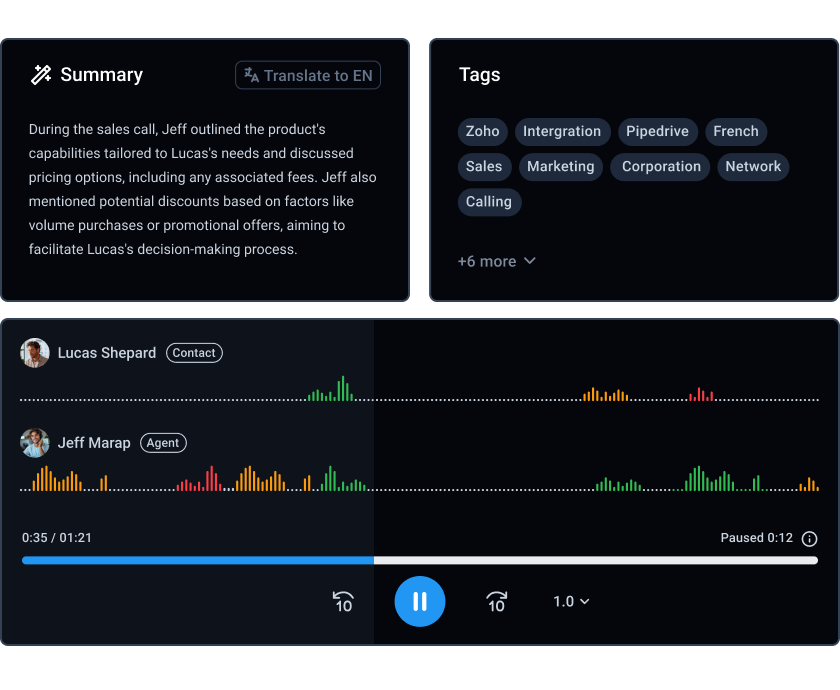
Smart Call Routing and IVR Systems
Other essential omnichannel support tools to be aware of include smart Call Routing and interactive Voice Response systems. These optimize call flows and allow customers to state the nature of their call before they even connect to an agent. This means people are connected to the right agent every time since call routing ensures they speak with the most appropriate person based on the nature of their call.
IVR systems can also be set up to automatically handle simple queries. For instance, customers can provide an order number and check the status of their delivery without the need for human intervention.
The system can also automatically route calls to departments or agents based on call volumes or agent skill sets, ensuring queues are effectively managed during peak hours and frustration is minimized.

Real-Time Dashboards and Analytics
Call center Analytics and Real-Time Dashboards are your gateway to accurately assessing how well your omnichannel strategy is performing. By allowing you to monitor key performance indicators (KPIs) and make data-driven decisions, analytics tools can significantly transform your bottom line.
This empowers you to take a continuous improvement approach, identifying areas to enhance agent performance, customer interactions, and overall efficiency.
Communications platforms like CloudTalk offer fully customizable dashboards to monitor key metrics. These can be tailored to display the most relevant data for your operation, including average call duration, wait times, resolution rates, and customer satisfaction scores.
You can also view real-time monitoring of ongoing calls to track agent performance and flag issues as and when they happen.
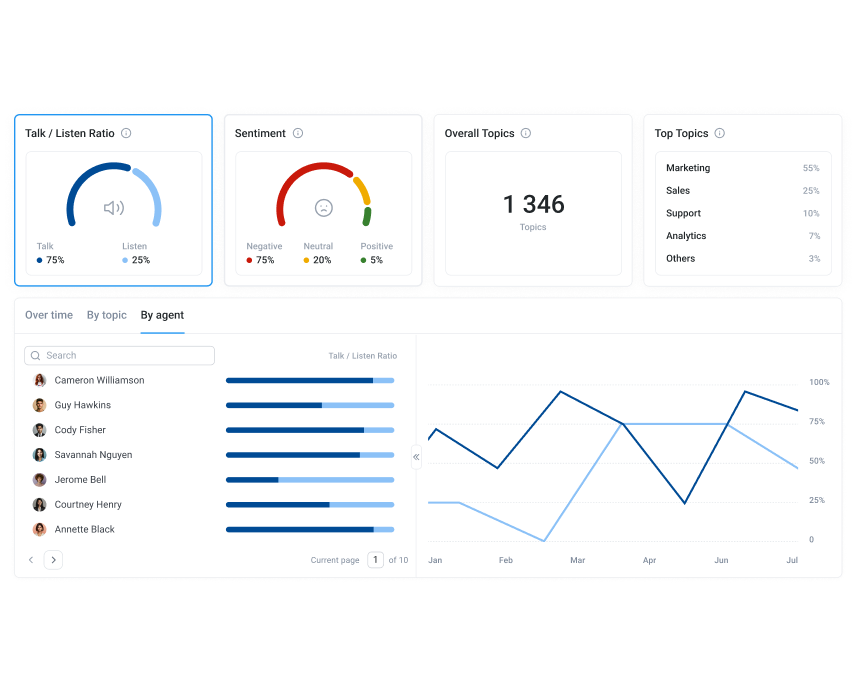
Leverage an Omnichannel Approach and Delight Customers
55% of people report that communicating with a business often feels like talking to completely separate departments instead of one cohesive company*. But by integrating all of your communications tools into a single platform you can ensure a consistent experience and a more personalized one.
Just be sure to build a tech stack that provides you with the data you need to save agents time and support customers. CloudTalk is a core part of this tech stack, with powerful dialing features, integration with your existing CRM or customer service software, and AI features to boost productivity and save time.
Support your agents, delight your customers
*Sources
- Salesforce, State of the connected customer, 2024
- McKinsey, Insights from where is customer care report, 2024
Frequently Asked Questions about Omnichannel Call Centers
What’s an omnichannel call center solution?
Omnichannel call center solutions integrate multiple communication channels into one platform for personalised and efficient call center operations.
What’s the definition of an omnichannel call center?
An omnichannel call center lets customers interact with the business through whichever integrated channel they prefer for a personalized experience.
What’s an example of omnichannel call center software?
CloudTalk’s VOIP software is an example of one component of omnichannel call center software, with features like CRM integration for unified support.
What are the benefits of an omnichannel call center?
An omnichannel call center enhances customer engagement, supports various channels, improves customer retention, and aligns with evolving customer expectations.
What are some omnichannel contact center features?
AI-powered chatbots, self-service options, automation, cloud-based solutions, mobile app integration, and live agent support across digital channels.











